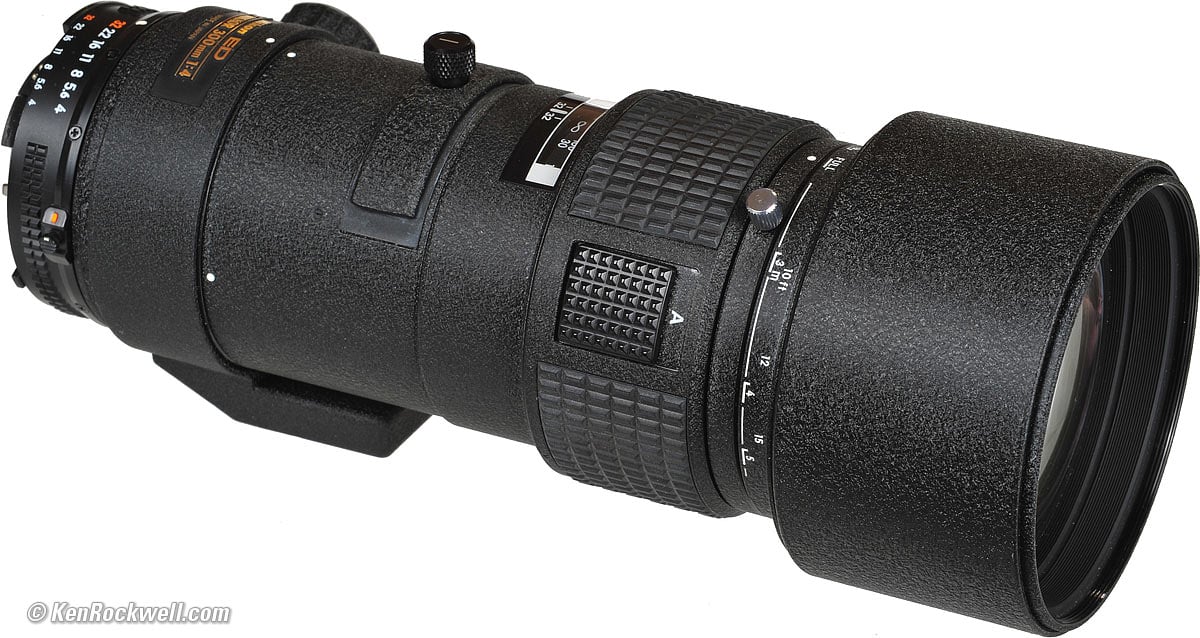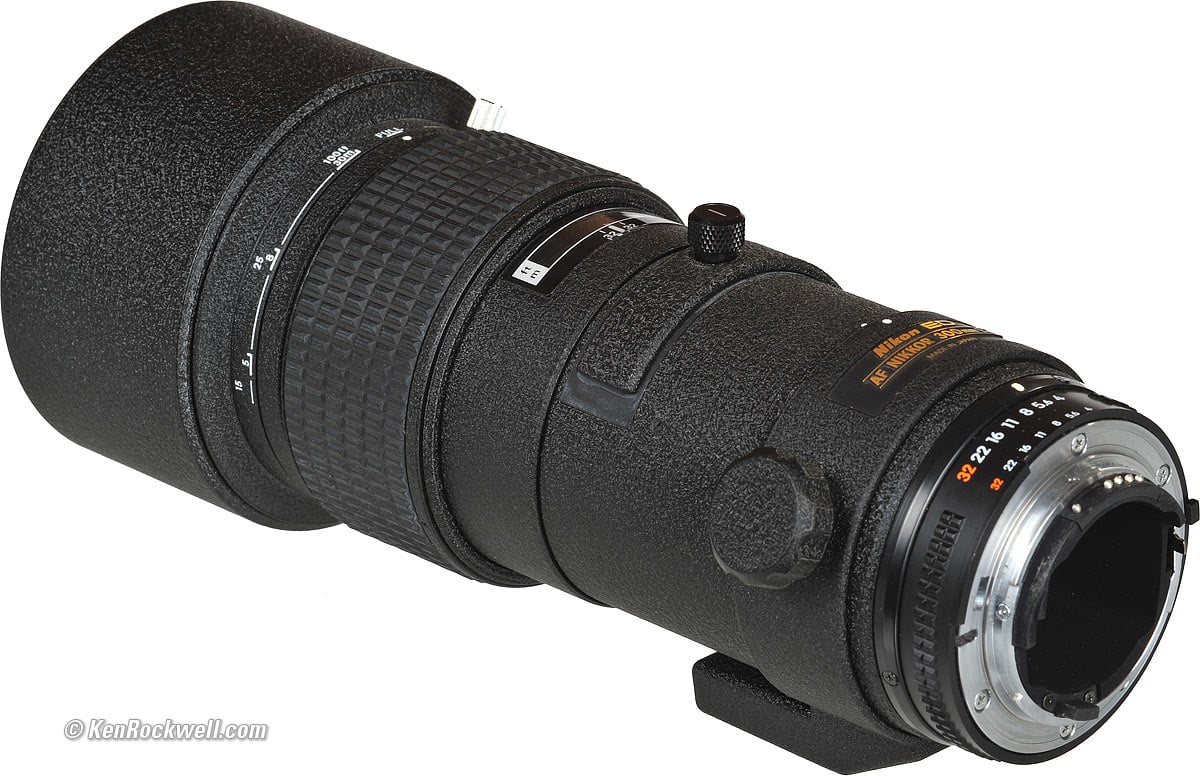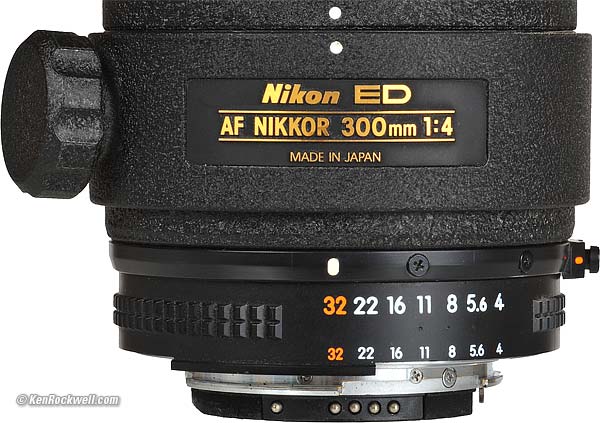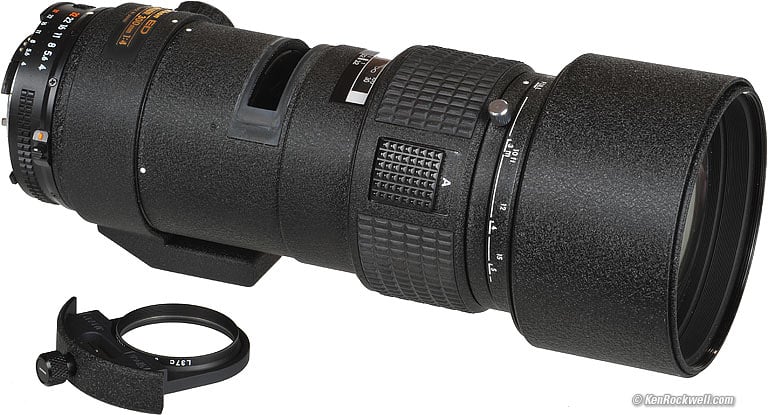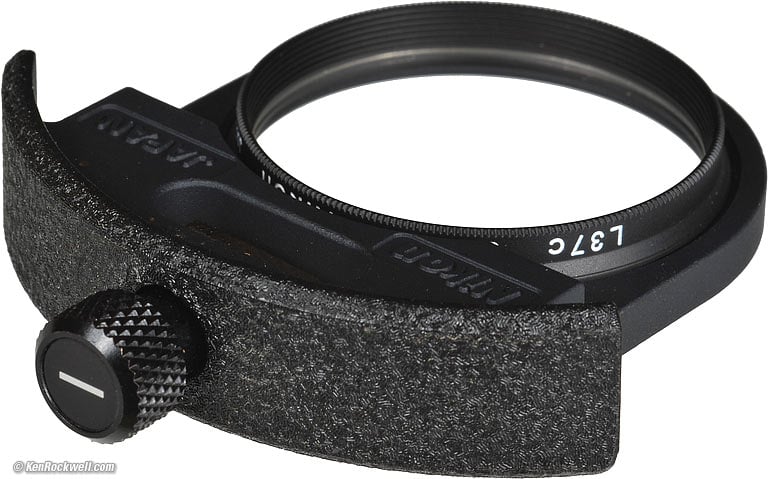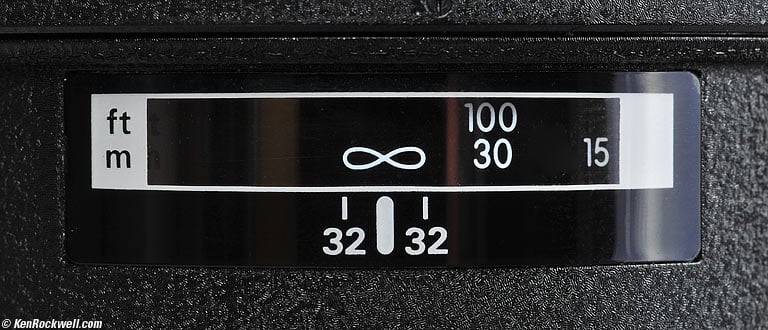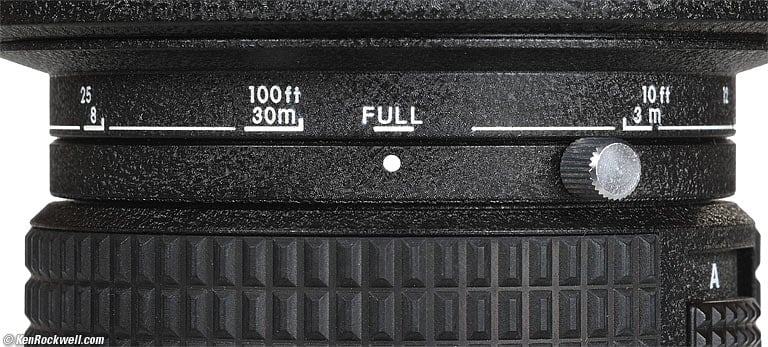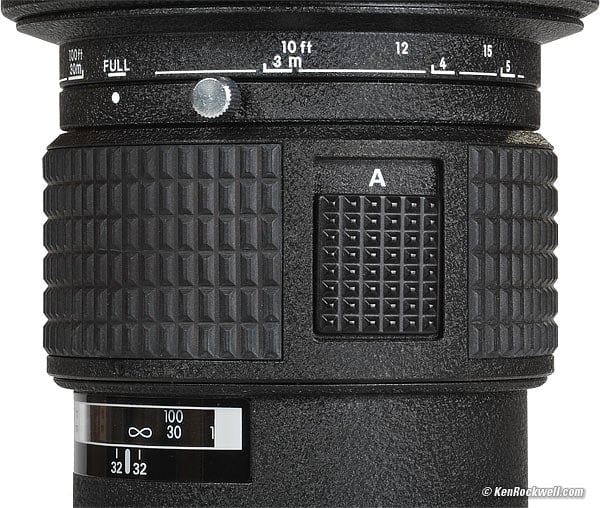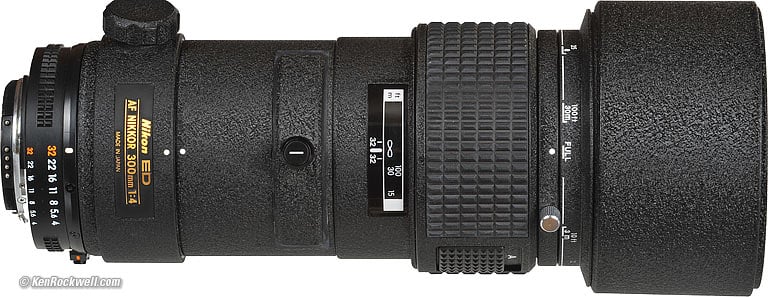Nikon 300mm f/4 AF
(1987-2000)
Nikon 300mm f/4 AF (FX, DX and 35mm coverage, metal 82mm filter thread, 46.9 oz./1,330g., 8'/2.5m close focus, about $250 used). enlarge. I got mine used at eBay (see How to Win at eBay).
This all-content, junk-free website's biggest source of support is when you use any of these links to approved sources when you get anything, regardless of the country in which you live. Camera boxes are not sealed, so never buy at retail or any source not on my personally approved list since you'll have no way of knowing if you're getting a defective or damaged customer return or a used lens. Buy only from the approved sources I use myself for the best prices, service, return policies and selection. Thanks for your support! Ken.
2:22 PM, 22 February 2022 Better Pictures Nikon Nikon Lenses Nikon Flash All Reviews
All Nikon 300mm f/4 Lenses Compared
Why Fixed Lenses Take Better Pictures
IntroductionThis is a great lens. First I'll praise the unusually good mechanics and then get to the optics.
It was plugged in the March 2000 issue of Outdoor Photographer magazine for it's superb performance mated with much smaller size and price in comparison to the 300/2.8. Not bad for a lens introduced in the 1980s and unchanged over its 13-year production life.
Nikon didn't mess around with this gem. The 300/4 AF is built tough, in fact tougher than any other current under - $2,000 Nikkor lens. Nikon's super-teles used to be tanks, although their AF-s lenses are returning to plastic. This 300 is likely to be the toughest compact 300 AF Nikon will ever make.
It's made almost entirely of metal. If you want SOLID, this is your lens. Even the front lens cover is a fake leather sock with a drawstring, just like Nikon's huge super-telephotos, and has the same drop-in 39mm filter holder. This holder is interchangeable with many other older $10,000 Nikon super telephotos that take 39mm filters. A second gelatin filter holder and case is included with new lenses.
Compatibility
This traditional AF lens becomes manual-focus-only on the FTZ, with a CPU for full data communication, aperture control and all exposure modes. It has no internal optical stabilization.
As a traditional AF lens, the Nikon AF 300mm f/4 works on a broader range of Nikon cameras than any other kind of lens. Except that it won't autofocus on the D40, D40x, or D60 and that you'll have to have an AI coupling prong added to the aperture ring for coupled metering with antediluvian Nikons made from 1959 - 1976, this lens works perfectly with every Nikon ever made since 1977.
See Nikon Lens Compatibility for details on your camera. Read down the "AF, AF-D (screw)" column for this lens.
History
Nikon introduced this 300mm f/4 AF in 1987 in response to people who complained about Nikon's first plasticy AF lenses, which were introduced to go with the very amateur N2020 camera.
In late 2000 Nikon Nikon replaced this with an AF-S version. I have not photographed with the AFS lens, however it seems potentially superior in every way, especially since it focuses down to 5 feet (1.5m).
Nikon 300m f/4 AF. enlarge.
Specifications
Identification Plate, Nikon 300mm f/4 AF.
Optics
8 elements in 6 groups. Multicoated. 2 ED elements
Close Focus
8 feet or 2.5m.
Depth-of-Field Scale
Only for f/32.
Infra-Red Focus Index
No.
Diaphragm
9 straight blades.
Stops down to f/32.
Front Cap
Phony leather cap, just like the huge Nikkor telephotos.
A replacement costs $40! (UPC symbol 18208 || 00596.)
There is no conventional snap-in plastic 82mm cap from Nikon.
The rear cap is the same as every other Nikon lens.
Filters
82mm front metal thread.
39mm internal filter holder. The Nikon part number for a 39mm NC clear filter (only) is 2478NASI, and is 2256 for a 39mm A12.
Hood
Built-in telescoping hood.
Tripod Collar
Permanently attached.
Size
3.5" (89mm) around by 8.6" (219mm) long.
Weight
46.9 oz. (1,330 g).
Price
22/02/2022: About $250 used at eBay if you know How to Win at eBay.
2015: About $450 used at eBay if you know How to Win at eBay.
Internal 39mm Filter Holder
Nikon 300mm f/4 AF with 39mm filter holder.
Nikon Drop-in 39mm Filter Holder. The filters screw into this holder, which pops into the lens.
The internal filter should remain in place because the presence or absence of the filter changes the effective (optical) distance to the film plane by a tiny amount. Don't worry about this, but please leave the filter holder in place.
The change in effective path length is the thickness of the filter x ([the filter glass' index of refraction] -1 ). A typical index of refraction is about 1.5, so you change the effective distance to the film by about half the thickness of the filter. Of course the same effect happens with filters in front of your lens, but no one notices when you change the distance to a subject by a millimeter. In lens design, moving the film plane a mm can make a difference, but not much with telephotos.
You can confirm this effect if you focus on a distant object and note the indication on the focus scale. Now remove the internal filter, refocus, and you will note that the focus scale indicates a different distance when focused on the same object.
So do you care? To be honest, it is a very subtle change and probably not worth worrying about unless you are the guy who designed the lens and take it personally. On the other hand, there is no better place to leave your 39mm filter than safe and sound inside your 300mm. The lens was designed expecting to have the internal filter in place. Of course if you use the internal gel holder then you also are not optimizing the operation of the lens, but that's insignificant compared to the significant effect of the reason you have chosen a special gel filter in the first place.
The effects of a front mounted filter have nothing to do with the performance of the lens or presence or absence of the internal filter, beyond of course the two colors adding together.
Performance
This is an excellent lens optically as well as mechanically.
Focus
Nikon 300mm f/4 AF Focus Window.
AF Speed
AF speed is on the slow side on my F100. It is a mechanically focused lens. It will probably be slower on more primitive cameras. One full turn of the AF screw focuses the lens from infinity to 95 feet.
Nikon 300mm f/4 Focus Limiter.
The focus limiter is continuously variable. You may choose any near or far distance as a limit. One of the limits is always either infinity or the close limit of 9' or 2.5m.
Nikon 300mm f/4 Focus Limiter and AF/MF Switch.
It's more of a pig than most Nikkors to switch between AF and MF. Unlike an AF-S or a Canon lens, you have to move TWO switches to do this! This is the main advantage of the AF-S 300 f/4 over this lens.
Not only do you have to move the switch on the camera, but you also have to move the big klunky switch on the lens focus ring itself. If you leave the lens' focus mode selector set to MF, then the big fat manual focus ring rotates as the camera tries to AF. This makes it tougher for the camera, and also makes it likely that you'll accidentally disturb the ring while the camera is trying to focus.
Color Rendition
I have seen different color rendition between samples. This is confirmed by looking at the coloration in the reflections off the lens elements: the multicoating can very between samples.
My first sample was a few CC too green, so I corrected this by using an 82mm Tiffen 812 filter on the front all the time instead of a Nikon A2. The 812 subtracts a little green.
Distortion
Like most fixed telephoto lenses, there is no visible distortion.
If you try to find distortion deliberately, you'll see only the tiniest amount of pincushion. It doesn't vary with distance. If you want to correct it perfectly, use a value of of -0.45 in Photoshop CS2's lens distortion filter to correct the distortion on a full-frame or FX camera. Forget about it on DX.
Falloff
There's some falloff at f/4, almost no falloff at f/5.6 and none at f/8.
Ghosts
Used with an uncoated Tiffen filter I get a slight mirror-image ghost at f/5.6, and none at f/11.
Sharpness
It's sharp! I can't see any significant variation in sharpness regardless of position in the full FX frame or f/stop.
Teleconverters
Used with the TC-200 it is not quite as sharp as a Nikkor 600mm f/5.6 ED-IF AI-s, but that's to be expected. It's certainly not bad at all, and if you don't already have a 600mm lens, go for it!
Nikon makes no AF teleconverters for this lens. See Teleconverters for more.
VR (Image Stabilization)
This lens has no internal optical stabilization, however it works with internal sensor-shift Image Stabilization (IS or VR (Vibration Reduction)) in some of Nikon's mirrorless Z cameras with the FTZ adapter.
"Percent Perfectly Sharp Shots" are the percentage of frames with 100% perfect tripod-equivalent sharpness I get when I'm shooting hand-held while free-standing with no support or bracing. This is a very strict test; in actual shooting at typical print sizes I get acceptable sharpness at much slower speeds, but for the purposes of seeing how much improvement an IS system gives, this is the most precise method.
Hand tremor is a random occurrence, so at marginal speeds some frames will be perfectly sharp while others will be in various stages of blur — all at the same shutter speed. This rates what percentage of shots are perfectly sharp, not how sharp are all the frames:
| % Perfectly Sharp Shots on Z9 on FTZ | 1/2 |
1/4 |
1/8 |
1/15 |
1/30 |
1/60 |
1/125 |
1/250 |
1/500 |
| Stabilization ON | 0 |
11 |
40 |
38 |
100 |
100 |
100 |
100 |
100 |
| Stabilization OFF | 0 |
0 |
0 |
0 |
0 |
33 |
0 |
67 |
100 |
I see about a four stop real-world improvement.
VR on 35mm Film
Here are the percentage of shots which I can get at 100% tripod-equivalent sharpness, as viewed at 100% on-monitor, hand-held on an FX camera at 12MP. I explain these ratings at Why VR Matters. I get the same results on Fuji Velvia on my F100:
1/30 |
1/60 |
1/125 |
1/250 |
1/500 |
10% |
15% |
50% |
80% |
100% |
Since I get perfectly sharp shots 50% of the time at 1/125, and the formula says this ought to happen at 1/300, that gives me a 1-1/3 stops improvement. Marketing is funny; marketing people would tell you the Nikon 300mm f/4 AF has a 1-stop improvement over a non-VR lens. Heh heh. It does this well because I hold cameras well, and because its heavy front element helps stabilize the system.
Nikon 300mm f/4 AF. enlarge.
Recommendations
This 300mm has superb optics and moderate speed. I'd get it for shooting careful landscapes where optical quality is one's only concern.
For most people, the 70-300mm VR sells new for less money in 2008 than this lens sells for used, and the 70-300mm VR is a far more useful lens for most people, especially for sports and action. The new VR lens offers zooming, faster AF, instant manual focus override and VR so you can skip the tripod. For still subjects, the VR of the 70-300mm VR will let one shoot in lower light than the extra stop offered by this 300mm f/4.
If buying used make sure to get the case, 39mm filter and holder and front cap it came with. Watch out if you buy a used one and there is no cap, I'm sure Nikon gets $40 for this special cap. Also make sure to check the diaphragm blades from the rear because they are naked inside. Make sure you get a 39mm filter attached inside the internal filter holder. The lens also probably ships with a gel filter holder that goes in the same place that the 39mm filter holder goes, so make a stink if you look at one that's missing that.
I leave the hard original Nikon case at home, and instead carry this 300mm around in a Lowepro "Street & Field" lens case #4.
I have only once played with the new (introduced in 2000) 300mm f/4 AF-S lens that sells for $1,100. If the optics are as good, it looks like the new lens is slightly bigger but otherwise better on all fronts. The AFS takes the smaller and more common 77mm filters, has a locking built in hood, has all the advantages of fast AFS focusing, is made of manly metal and not crappy plastic and most importantly, focuses as close as 5 feet (1.5m). Cost aside, I want to get the AFS lens for evaluation.
On Digital
This is a great choice for FX cameras like the D3, D3X and D700.
This 300mm doesn't autofocus on the D40, D40x, or D60.
On 35mm Film
I focus this lens by running my F100 with the custom function set so that the camera focuses ONLY when I press the AF button. This way I don't have to keep messing with two switches on both the lens and camera to change from AF to MF.
I usually shoot it at f/4; I shoot slow 50 speed film and need all the light I can get.
Here are animal photos I've made with the lens bullfrog and dragonfly. These were cropped. The 300/4 only focuses to 9;' I wish it focused closer as I'm always at the stop when photographing little animals with it.
Hand held on my F100 it's sharp half the time at 1/100 of a second.
With the F100 on a tripod with no bean bags or other damping it's sharp down to 1/30. The F100's vibration due to the crippling lack of mirror lockup (called the "Nikon Recoil" by Canon fans) means you can't use the lens between 1/15 and 1/8 of a second. It's so-so at 1/4 and 1/2, and by 1 second or longer most of the vibration has damped out for most of the exposure time so your results can be OK, unless you have bright points of light in the image that will record a smear.
I use a clear (UV) protective filter instead of a cap so I'm always ready to shoot instantly. I only use a cap when I throw this in a bag with other gear without padding — which is never. The UV filter never gets in the way, and never gets lost, either.
The very best protective filter is the 82mm Hoya multicoated HD3 UV which uses hardened glass and repels dirt and fingerprints. The Nikon NC 82mm is also an excellent choice, but not as resistant to the environment as the HD3 UV.
For less money, the B+W 82mm 010 is an excellent filter, as is the multicoated version, but the Hoya HD3 is the toughest and the best.
Any of these filters protects as well and gives ultrasharp images, but since filters last a lifetime, you may as well get the best since the Hoya HD3 is tougher and stays cleaner than the others since it repels oil and dirt.
All these filters are just as sharp and take the same pictures, the difference is how much abuse they'll take and stay clean and stay in one piece. Since filters last a lifetime or more, there's no reason not to buy the best as it will last you for the next 40 years. Filters aren't throwaways like digital cameras which we replace every few years, like it or not. I'm still using filters I bought back in the 1970s!
© Ken Rockwell. All rights reserved. Tous droits réservés. Alle Rechte vorbehalten. Ken Rockwell® is a registered trademark.
Help Me Help You top
I support my growing family through this website, as crazy as it might seem.
The biggest help is when you use any of these links when you get anything. It costs you nothing, and is this site's, and thus my family's, biggest source of support. These places always have the best prices and service, which is why I've used them since before this website existed. I recommend them all personally.
If you find this page as helpful as a book you might have had to buy or a workshop you may have had to take, feel free to help me continue helping everyone.
If you've gotten your gear through one of my links or helped otherwise, you're family. It's great people like you who allow me to keep adding to this site full-time. Thanks!
If you haven't helped yet, please do, and consider helping me with a gift of $5.00.
As this page is copyrighted and formally registered, it is unlawful to make copies, especially in the form of printouts for personal use. If you wish to make a printout for personal use, you are granted one-time permission only if you PayPal me $5.00 per printout or part thereof. Thank you!
Thanks for reading!
Ken.
